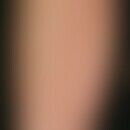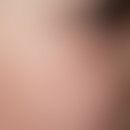Synonym(s)
Hair nodule disease; Hodara disease; Hodar's disease; Paxton's disease; Trichonodose
HistoryThis section has been translated automatically.
Wilks 1859; Beigel 1855;
DefinitionThis section has been translated automatically.
Acquired or (more rarely) congenital nodular hair shaft alteration with dull, rough, split, easily broken hair.
You might also be interested in
EtiopathogenesisThis section has been translated automatically.
Defects in the cuticle lead to the loss of cortical cells and intercellular cement substance and ultimately to incomplete shaft fractures. The phenomenon can be:
be congenital:
- Trichothiodystrophy
- Argininosuccinic acid syndrome
- Biotinidase defect
- Trichohepatoenteric syndrome 1;
or far more frequently acquired:
- Physical or chemical noxious agents. The nodular hair shaft abnormalities can occur proximally (due to tight hairstyles) or distally (after repeated chemical or mechanical hair procedures - e.g. bleaching the hair, straightening the hair). The phenomenon is common in African-Americans who straighten their natural hair (Haskin A et al. 2017).
Trichorrhexis nodosa is often combined with trichoptilosis.
ClinicThis section has been translated automatically.
Periodic thickening of the hair shaft due to bristle-brush-like splintering of the hair.
TherapyThis section has been translated automatically.
Elimination of possible exogenous causes, greasing of the hair with e.g. Ol. olivarum, see also trichoclasis.
LiteratureThis section has been translated automatically.
- Haskin A et al (2017) Breaking the cycle of hair breakage: pearls for the management of acquired trichorrhexis nodosa. J Dermatologist Treat 28:322-326.
- Hwang ST et al (2013) Trichorrhexis nodosa after hair transplantation: dermoscopic, pathologic and electron microscopy analyses. Dermatol Surgery 39: 1721-1724
- Kharkar V et al (2011) Trichorrhexis nodosa with nail dystrophy: diagnosis by dermoscopy. Int J Trichology 3:105-106
- Lünnemann L et al (2013) Hair-shaft abnormality in a 7-year-old girl. Trichorrhexis nodosa dueto biotinidase deficiency. JAMA Dermatol 149:357-363
- Ogunbiyi A et al.(2014) Recurrent hair loss resulting from generalized proximal trichorrhexis nodosa in a Nigerian female. Int J Trichology 6:83-84
- Sisto T et al (2015) Inability to grow long hair: a presentation of trichorrhexis nodosa. Cutis 95:E15-16
Incoming links (21)
Arginic succinic acid syndrome; Comel-netherton syndrome; Frizz; Hair nodule disease; Hair nodules; Hair shaft anomalies (overview); Hodara disease; Hodar's disease; Laron syndrome; Monilethrix; ... Show allOutgoing links (5)
Arginic succinic acid syndrome; Trichoclasia; Trichohepatoenteric syndrome; Trichoptilosis; Trichothiodystrophy;Disclaimer
Please ask your physician for a reliable diagnosis. This website is only meant as a reference.








